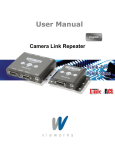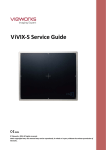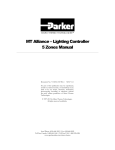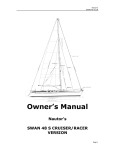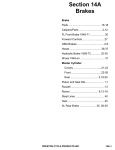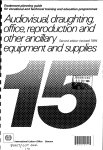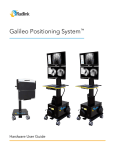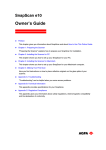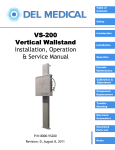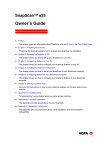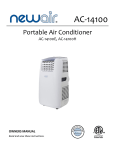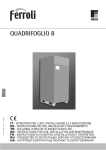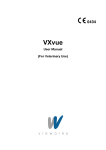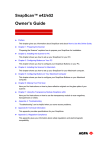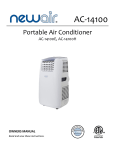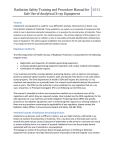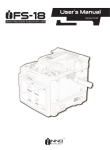Download DX-D 40C, DX-D 40G - Brown`s Medical Imaging
Transcript
DX-D 40C, DX-D 40G FXRD-1417WA FXRD-1417WB User Manual 0290A EN 20140626 1622 2 | DX-D 40C, DX-D 40G | Contents Contents Legal Notice ..........................................................................4 Introduction to this Manual ................................................... 5 Scope .........................................................................6 Documentation by the manufacturer ..............6 Warnings, Cautions, Instructions and Notes ...............7 Disclaimer ................................................................. 8 Introduction to the DR Detector .............................................9 Intended Use ........................................................... 10 Intended User .......................................................... 10 Configuration .......................................................... 11 Equipment Classification ......................................... 12 Non-medical equipment .............................. 12 Options and Accessories ...........................................13 Recommended grid specifications ................13 Operation Controls .................................................. 14 DX-D 40C, DX-D 40G ................................... 15 DR Detector Battery Charger ........................16 System Control Unit .....................................17 DR Detector Switch on the NX Workstation .... 18 System Documentation ............................................19 Documentation by the manufacturer ............19 Training ...................................................................20 Product Complaints ................................................. 21 Compatibility ...........................................................22 Compliance ............................................................. 23 Documentation by the manufacturer ............23 Connectivity ............................................................ 24 Wireless Communication ............................. 25 Wired communication ................................. 26 Installation .............................................................. 27 Environment of Use ..................................... 27 Messages ................................................................. 29 Labels ...................................................................... 30 DR Detector identification label ................... 31 Documentation by the manufacturer ............32 Cleaning and Disinfecting ........................................ 33 Cleaning ...................................................... 34 Use of protective plastic bag .........................35 Disinfecting ................................................. 36 Approved disinfectants ................................ 37 Safety directions for disinfection ..................38 Maintenance ............................................................40 Daily inspection ........................................... 41 Half-yearly inspection ..................................42 0290A EN 20140626 1622 DX-D 40C, DX-D 40G | Contents | 3 Regular Inspection and Maintenance ........... 43 Replacement Parts Support ..........................44 Repair ..........................................................45 Environmental Protection ........................................ 46 Safety Directions ......................................................48 DR Detector Battery ..................................... 51 Safety directions for the power supply ......... 53 Safety directions for the System Control Unit ... 55 Getting started .....................................................................56 Starting the DR Detector ..........................................57 Basic Workflow DR Detector .................................... 59 Step 1: retrieve the patient info ....................60 Step 2: select the exposure ...........................60 Step 3: prepare the exposure ........................61 Step 4: check the exposure settings .............. 62 Step 5: execute the exposure ........................63 Positioning the DR Detector ......................... 64 Guidelines for Pediatric Applications ....................... 67 Stopping the DR Detector ........................................ 69 Advanced Operating ............................................................ 70 Detector Status Indicators ........................................71 Charging a battery ................................................... 72 Problem solving ...................................................................73 Artifact in DR Detector images ................................. 74 DX-D 40C, DX-D 40G .............................................. 75 Technical Data .....................................................................77 DX-D 40C, DX-D 40G ............................................... 78 DX-D 40C, DX-D 40G Battery ................................... 80 DX-D 40C, DX-D 40G Battery Charger ......................81 System Control Unit .................................................82 Remarks for HF-emission and immunity .............................. 83 Documentation by the manufacturer ....................... 83 0290A EN 20140626 1622 4 | DX-D 40C, DX-D 40G | Legal Notice Legal Notice 0434 Vieworks Co., Ltd. #107-108, 601-610, Suntechcity 2, 52 Sagimakgol-ro (307-2, Sangdaewon-dong), Jungwon-gu, Seongnam-si, Gyeonggi-do, 462-736, South Korea For more information on Agfa products and Agfa HealthCare products, please visit www.agfa.com. Agfa and the Agfa rhombus are trademarks of Agfa-Gevaert N.V., Belgium or its affiliates. DX-D 40G and DR 40C are trademarks of Agfa HealthCare N.V., Belgium or one of its affiliates. All other trademarks are held by their respective owners and are used in an editorial fashion with no intention of infringement. Agfa HealthCare N.V. makes no warranties or representation, expressed or implied, with respect to the accuracy, completeness or usefulness of the information contained in this document and specifically disclaims warranties of suitability for any particular purpose. Products and services may not be available for your local area. Please contact your local sales representative for availability information. Agfa HealthCare N.V. diligently strives to provide as accurate information as possible, but shall not be responsible for any typographical error. Agfa HealthCare N.V. shall under no circumstances be liable for any damage arising from the use or inability to use any information, apparatus, method or process disclosed in this document. Agfa HealthCare N.V. reserves the right to make changes to this document without prior notice. The original version of this document is in English. Copyright 2014 Agfa HealthCare N.V All rights reserved. Published by Agfa HealthCare N.V. B-2640 Mortsel - Belgium. No part of this document may be reproduced, copied, adapted or transmitted in any form or by any means without the written permission of Agfa HealthCare N.V. 0290A EN 20140626 1622 DX-D 40C, DX-D 40G | Introduction to this Manual | 5 Introduction to this Manual Topics: • • • Scope Warnings, Cautions, Instructions and Notes Disclaimer 0290A EN 20140626 1622 6 | DX-D 40C, DX-D 40G | Introduction to this Manual Scope This manual contains information for the safe and effective operation of the DX-D 40C and DX-D 40G wireless DR Detectors and peripheral equipment, further referred to as the DR Detector. Documentation by the manufacturer For complete safety directions and technical documentation, refer to the ViVIX-S 1417W User Manual that is delivered with the product. 0290A EN 20140626 1622 DX-D 40C, DX-D 40G | Introduction to this Manual | 7 Warnings, Cautions, Instructions and Notes The following samples show how warnings, cautions, instructions and notes appear in this document. The text explains their intended use. Warning: Warnings are directions which, if they are not followed, can cause fatal or serious injuries to a user, engineer, patient or any other person or can lead to a mistreatment. Caution: Cautions are directions which, if they are not followed, can cause damage to the equipment described in this manual or any other equipment or goods and can cause environmental pollution. Instruction: This sign is typically used in combination with the warning sign when providing a specific instruction. If it is followed exactly, it should avoid the subject of the warning. Note: Notes provide advice and highlight unusual points. A note is not intended as an instruction. 0290A EN 20140626 1622 8 | DX-D 40C, DX-D 40G | Introduction to this Manual Disclaimer Agfa assumes no liability for use of this document if any unauthorized changes to the content or format have been made. Every care has been taken to ensure the accuracy of the information in this document. However, Agfa assumes no responsibility or liability for errors, inaccuracies or omissions that may appear in this document. To improve reliability, function or design Agfa reserves the right to change the product without further notice. This manual is provided without warranty of any kind, implied or expressed, including, but not limited to, the implied warranties of merchantability and fitness for a particular purpose. Caution: In the United States, Federal law restricts this device to sale by or on the order of a physician. 0290A EN 20140626 1622 DX-D 40C, DX-D 40G | Introduction to the DR Detector | 9 Introduction to the DR Detector Topics: • • • • • • • • • • • • • • • • • • • Intended Use Intended User Configuration Equipment Classification Options and Accessories Operation Controls System Documentation Training Product Complaints Compatibility Compliance Connectivity Installation Messages Labels Cleaning and Disinfecting Maintenance Environmental Protection Safety Directions 0290A EN 20140626 1622 10 | DX-D 40C, DX-D 40G | Introduction to the DR Detector Intended Use The DR Detector is a wired and wireless radiographic digital X-ray imaging device commonly referred to as flat panel detector. It is designed for all general radiography applications. The DR Detector will be used in a radiological environment by qualified staff to capture the X-ray images and send these images to the imaging processing software. The DR Detector is not intended for mammography applications. Intended User This manual is written for trained users of Agfa products. Users are considered as the persons who actually handle the equipment as well as the persons having authority over the equipment. Before attempting to work with this equipment, the user must read, understand, note and strictly observe all warnings, cautions and safety markings on the equipment. Only a physician or a legally certified operator should use this product. 0290A EN 20140626 1622 DX-D 40C, DX-D 40G | Introduction to the DR Detector | 11 Configuration The DR Detector is a component that can be integrated in an X-ray system, connected to a workstation and to the X-ray generator. 3 2 1 6 4 5 1. 2. 3. 4. 5. 6. DR Detector DR Detector battery DR Detector battery charger System Control Unit (including a wireless access point) Workstation X-ray generator Figure 1: DR Detector configuration 0290A EN 20140626 1622 12 | DX-D 40C, DX-D 40G | Introduction to the DR Detector Equipment Classification Per EN/IEC60601-1, Medical Electrical Equipment, General Requirements for Safety 3rd Edition, the DR Detector, including the battery pack, is classified as following. Class I equipment Internally powered Type B equipment A Type B piece of equipment is one that provides a particular degree of protection against electric shock particularly regarding allowable leakage current and reliability of the protective earth protection. Water ingress This device does not have protection against ingress of water. Flammable anesthetics This device is not suitable for use in the presence of a flammable anesthetic mixture with air, or in presence of a flammable anesthetic mixture with oxygen or nitrous oxide. Operation Continuous operation. Applied Parts The DR Detector tube side is an applied part. Non-medical equipment Following components are classified as non-medical equipment: • DR Detector battery charger • System Control Unit • Workstation 0290A EN 20140626 1622 DX-D 40C, DX-D 40G | Introduction to the DR Detector | 13 Options and Accessories • • • • DR Detector battery DR Detector battery charger Handle with screws Click-on grid Recommended grid specifications Size 14 inch x 17 inch Ratio 10:1 or 6:1 Line pairs per inch 215 SID range 1 m - 1.8 m Orientation Longitudinal 0290A EN 20140626 1622 14 | DX-D 40C, DX-D 40G | Introduction to the DR Detector Operation Controls Topics: • • • • DX-D 40C, DX-D 40G DR Detector Battery Charger System Control Unit DR Detector Switch on the NX Workstation 0290A EN 20140626 1622 DX-D 40C, DX-D 40G | Introduction to the DR Detector | 15 DX-D 40C, DX-D 40G 1 2 4 3 5 6 7 1. DR Detector battery lock lever Unlock the battery. 2. DR Detector battery Supplies power to the detector during wireless communication. 3. Antenna of the wireless network adapter Operation in wireless configuration. 4. Effective imaging area border and center position indication 5. DR Detector connector Operation in wired configuration. 6. Status indicators • Blue indicator shows data communication status. • Orange indicator shows if the detector is ready. • Green indicator shows power on/off status of the detector. 7. On/off switch Figure 2: DR Detector operation controls Related Links Detector Status Indicators on page 71 0290A EN 20140626 1622 16 | DX-D 40C, DX-D 40G | Introduction to the DR Detector DR Detector Battery Charger The battery charger has three slots to insert a battery. Figure 3: DR Detector Battery Charger Warning: Do not use the battery charger within the patient’s vicinity. Related Links Safety directions for the power supply on page 53 0290A EN 20140626 1622 DX-D 40C, DX-D 40G | Introduction to the DR Detector | 17 System Control Unit The System Control Unit is connected to the DR Detector via wireless network. 1 2 1. Power switch 2. Status indicator • Blinking green: starting up • Green: ready • Blue: communicating to the detector Figure 4: System Control Unit (SCU) Warning: Do not use the System Control Unit within the patient’s vicinity. Related Links Safety directions for the power supply on page 53 0290A EN 20140626 1622 18 | DX-D 40C, DX-D 40G | Introduction to the DR Detector DR Detector Switch on the NX Workstation The DR Detector Switch is available in the title bar of the NX application. The DR Detector Switch shows which DR Detector is active and shows its status. The DR Detector Switch can be used to activate another DR Detector. It is positioned in the title bar of the NX application. Battery status icon Meaning Full Medium Low Empty Connection status icon (wifi/ wired) Meaning Good Low Bad Wired DR Detector Panel status icon (blinking) Meaning 0290A EN 20140626 1622 Ready Initializing exposure Error Sleep DX-D 40C, DX-D 40G | Introduction to the DR Detector | 19 System Documentation The documentation consists of a User manual (this document) and related documentation: • • • • • • NX User Manual (4420). NX Key User Manual (4421). NX Getting Started Sheets (4424). NX Problem Solving Sheets (4425). DX-D DR Detector Calibration Key User Manual (0134). DX-D System User Documentation (if applicable). The documentation shall be kept with the system for easy reference. Technical documentation is available in the product service documentation which is available from your local support organization. Documentation by the manufacturer For complete safety directions and technical documentation, refer to the ViVIX-S 1417W User Manual that is delivered with the product. 0290A EN 20140626 1622 20 | DX-D 40C, DX-D 40G | Introduction to the DR Detector Training The user must have received adequate training on the safe and effective use of the system before attempting to work with it. Training requirements may vary from country to country. The user must make sure that training is received in accordance with local laws or regulations that have the force of law. Your local Agfa or dealer representative can provide further information on training. The user must note the following information in the previous section of this manual: • Intended Use. • Intended User. • Safety Directions. 0290A EN 20140626 1622 DX-D 40C, DX-D 40G | Introduction to the DR Detector | 21 Product Complaints Any health care professional (for example a customer or a user) who has any complaints or has experienced any dissatisfaction with the quality, durability, reliability, safety, effectiveness, or performance of this product must notify Agfa. If the device malfunctions and may have caused or contributed to a serious injury, Agfa must be notified immediately by telephone, fax or written correspondence to the following address: Agfa Service Support - local support addresses and phone numbers are listed on www.agfa.com Agfa - Septestraat 27, 2640 Mortsel, Belgium Agfa - Fax +32 3 444 7094 0290A EN 20140626 1622 22 | DX-D 40C, DX-D 40G | Introduction to the DR Detector Compatibility The system must only be used in combination with other equipment or components if these are expressly recognized by Agfa as compatible. A list of such equipment and components is available from Agfa service on request. Changes or additions to the equipment must only be carried out by persons authorized to do so by Agfa. Such changes must comply with best engineering practice and all applicable laws and regulations that have the force of law within the jurisdiction of the hospital. 0290A EN 20140626 1622 DX-D 40C, DX-D 40G | Introduction to the DR Detector | 23 Compliance Documentation by the manufacturer For complete safety directions and technical documentation, refer to the ViVIX-S 1417W User Manual that is delivered with the product. 0290A EN 20140626 1622 24 | DX-D 40C, DX-D 40G | Introduction to the DR Detector Connectivity Topics: • • Wireless Communication Wired communication 0290A EN 20140626 1622 DX-D 40C, DX-D 40G | Introduction to the DR Detector | 25 Wireless Communication Wireless communication is established between the internal wireless module of the DR Detector and the NX workstation via the wireless access point. The DR Detector is compliant with IEEE 802.11n (2.4 GHz/5 GHz). The available frequency band varies depending on local radio laws and system requirements. The frequency band (channel) of the DR Detector is selected at installation. Note: Use of multiple pieces of equipment that use the same frequency band (channel) may interfere with each wireless communication and cause a decline in transmission speed. Note: Before introducing other wireless equipment to the same environment where the DR Detector is set up, consult the system engineer or qualified personnel at the medical site. Note: Do not place obstacles in the way of the wireless access point. Otherwise, the properties of wireless communication, such as the throughput and operable distance, may decrease. Note: Transmitting the image data to the NX workstation takes a number of seconds. After making an exposure, stay with the detector in the direct neighbourhood (maximum 8 m) of the wireless access point until the image is available on the NX workstation. 0290A EN 20140626 1622 26 | DX-D 40C, DX-D 40G | Introduction to the DR Detector Wired communication The use of accessories and cables other than those specified or sold by the manufacturer as replacement parts, may result in increased radiation emissions or decreased stability of the equipment. Accessory equipment connected to the analog and digital interfaces must be certified according to the respective IEC standards. All combinations of equipment must be in compliance with IEC 60601-1-1 system requirements. Any person who connects additional equipment to the signal input or signal output ports, configures a medical system and is therefore responsible for ensuring that the system complies with the requirements of the system standard IEC 60601-1. 0290A EN 20140626 1622 DX-D 40C, DX-D 40G | Introduction to the DR Detector | 27 Installation Installation and configuration is performed by an Agfa trained and authorized service engineer. Contact your local support organization for more information. On a configuration with multiple DR Detectors of the same type, it is required to apply labeling to the DR Detector containing a unique nickname for each DR Detector. The nicknames must be configured on the NX Workstation. The DR Detector Switch shows which DR Detector is active and shows its status, by means of the nickname of the DR Detector. An identical label is attached to the bucky of the X-ray system to identify the dedicated workspace of each DR Detector. Environment of Use The equipment is mainly for use in X-ray exposure rooms, hospital wards and mobile medical examination vehicles. To use it in other places, consult your sales representative or local Agfa dealer. Warning: Do not install or store the equipment in any of the locations listed below. Doing so may result in failure or malfunction, equipment falling, or fire or injury: • • • • • • • • • • • Close to facilities where water is used Where it will be exposed to direct sunlight Close to the air outlet of an air-conditioner or ventilation equipment Close to a heat source such as a heater Where the power supply is unstable In a dusty environment In a saline or sulfurous environment Where temperature or humidity is high Where there is freezing or condensation In areas prone to vibration On an incline or in an unstable area Note: Do not use the detector near devices generating a strong magnetic field. Doing so may produce image noise or artifacts. Note: Do not use this equipment in combination with peripherals such as defibrillators or large electric motors as these may cause power-supply noise or power supply voltage variations. Doing so may prevent normal operation of this equipment and peripherals. 0290A EN 20140626 1622 28 | DX-D 40C, DX-D 40G | Introduction to the DR Detector Note: This product may malfunction due to electromagnetic waves caused by portable personal telephones, transceivers, radiocontrolled toys, etc. Be sure to avoid having objects such as these, which affect this product, brought near the product. Caution: Sudden heating of the room in cold areas will cause condensation to form on the equipment. In this case, wait until the condensation evaporates before use. If the equipment is used while condensation is formed on it, problems may occur. When an air-conditioner is used, be sure to raise/lower the temperature gradually so that a difference in temperature in the room and in the equipment does not occur, to prevent condensation. Warning: Do not use non-medical equipment in the patient’s vicinity. Figure 5: Patient’s vicinity Related Links DR Detector Battery Charger on page 16 System Control Unit on page 17 DR Detector Switch on the NX Workstation on page 18 0290A EN 20140626 1622 DX-D 40C, DX-D 40G | Introduction to the DR Detector | 29 Messages Under certain conditions the DR Detector shows a dialog box containing a message in the middle of the screen of the NX workstation. This message informs the user that either a problem has occurred or that a requested action cannot be performed. The user must read these messages carefully. They will provide information on what to do from then on. This will be either performing an action to resolve the problem or to contact the local service organization. Details on the contents of messages can be found in the service documentation which is available to local service personnel. 0290A EN 20140626 1622 30 | DX-D 40C, DX-D 40G | Introduction to the DR Detector Labels Symbol Explanation The system identification can be accessed by removing the battery. Topics: • • DR Detector identification label Documentation by the manufacturer 0290A EN 20140626 1622 DX-D 40C, DX-D 40G | Introduction to the DR Detector | 31 DR Detector identification label Label 1 Meaning Writable label to identify and dedicate a DR Detector to an Xray system bucky. 0290A EN 20140626 1622 32 | DX-D 40C, DX-D 40G | Introduction to the DR Detector Documentation by the manufacturer For complete safety directions and technical documentation, refer to the ViVIX-S 1417W User Manual that is delivered with the product. 0290A EN 20140626 1622 DX-D 40C, DX-D 40G | Introduction to the DR Detector | 33 Cleaning and Disinfecting All appropriate policies and procedures should be followed to avoid contamination of the staff, patients and equipment. All existing universal precautions should be extended to avoid potential contaminations and to avoid patients coming into (close) contact with the device. The user is responsible for selecting a disinfection procedure. Topics: • • • • • Cleaning Use of protective plastic bag Disinfecting Approved disinfectants Safety directions for disinfection 0290A EN 20140626 1622 34 | DX-D 40C, DX-D 40G | Introduction to the DR Detector Cleaning To clean the exterior of the equipment: 1. Stop the system Warning: When the equipment is going to be cleaned, be sure to turn OFF the power of each device, and to unplug the power cord from the AC outlet. Never use anhydrous or high solvency alcohols, benzine, thinner or any other flammable cleaning agent. Otherwise, it may result in fire or electric shock. 2. Wipe the exterior of the system with a cloth slightly moistened with a neutral detergent. Caution: Make sure no liquid gets in the device. Caution: Clean the equipment with only a little moisture. Do not spray disinfectants or detergents directly on the equipment. Do not pour liquid directly on the equipment. Caution: Do not use abrasvie brush and scraper to clean the product. Note: Do not open the equipment for cleaning. No components inside the device require cleaning by the user. 3. Start up the system. 0290A EN 20140626 1622 DX-D 40C, DX-D 40G | Introduction to the DR Detector | 35 Use of protective plastic bag Warning: Liquids ingressing the DR Detector may cause malfunction and contamination. If there is a chance that the detector comes in contact with liquids (bodily fluids, disinfectants,...), the DR Detector must be wrapped in a protective plastic bag while performing the examination. It is considered good clinical practice to use a single-use protective bag in all cases where contact of the device or contaminants is expected, to avoid contamination of others. 0290A EN 20140626 1622 36 | DX-D 40C, DX-D 40G | Introduction to the DR Detector Disinfecting To disinfect the device, use only disinfectants and disinfection methods that are approved by Agfa and that correspond to the national regulation and guidelines. If you plan to use other disinfectants, approval of Agfa is needed before use, as most disinfectants can damage the device. UV disinfection is also not allowed. Perform the procedure following the instructions for use, the disposal instructions and the safety instructions of the selected disinfectants and tools and of the hospital. 0290A EN 20140626 1622 DX-D 40C, DX-D 40G | Introduction to the DR Detector | 37 Approved disinfectants Refer to the Agfa website for specifications on the disinfectants that have been found compatible with the cover material of the device and can be used on the outer surface of the device. http://www.agfahealthcare.com/global/en/main/products_services/ product-info/technology/disinfectants_dx_d_systems.jsp 0290A EN 20140626 1622 38 | DX-D 40C, DX-D 40G | Introduction to the DR Detector Safety directions for disinfection Warning: When the equipment is going to be cleaned, be sure to turn OFF the power of each device, and to unplug the power cord from the AC outlet. Never use anhydrous or high solvency alcohols, benzine, thinner or any other flammable cleaning agent. Otherwise, it may result in fire or electric shock. Warning: All appropriate policies and procedures should be followed to avoid contamination of the staff, patients and equipment. Warning: Make sure that the equipment is properly decontaminated and disinfected before shipment. Warning: The selection and description of the appropriate disinfection procedure and policy is the responsibility of the user. Warning: All applicable instructions of the applied disinfecting product have to be followed (e.g. use, dilution, shelf life, storage, material compatibility, interaction with cleaning compounds, safe use, and disposal). Warning: Before disinfecting the equipment, assure that the equipment is clean. Warning: Do not pour liquid directly on the equipment. Always use a low-linting cloth dampened (not dripping) with the solution. Warning: Be sure that all surfaces are thoroughly dry before returning the equipment to use. Disinfecting solution may cause skin irritation to the patient. Warning: Use in well-ventilated areas. 0290A EN 20140626 1622 DX-D 40C, DX-D 40G | Introduction to the DR Detector | 39 Warning: Do not reuse wipes. Caution: Disinfecting solution or wipes may cause eye and skin irritation. Wear gloves and wash hands with soap and water following use. Consult the manufacturer’s Material Safety Data Sheets (MSDS) and recommendations on the product label for additional information prior to use. 0290A EN 20140626 1622 40 | DX-D 40C, DX-D 40G | Introduction to the DR Detector Maintenance Always consult the Agfa Service documentation and an Agfa trained and authorized service engineer for complete maintenance schedules. In order to ensure that the equipment is used safely and normally, be sure to inspect the equipment before use. If any problem is found during the inspection and cannot be corrected, please contact your sales representative or local dealer. Topics: • • • • • Daily inspection Half-yearly inspection Regular Inspection and Maintenance Replacement Parts Support Repair 0290A EN 20140626 1622 DX-D 40C, DX-D 40G | Introduction to the DR Detector | 41 Daily inspection Warning: For safety reasons, be sure to turn OFF the power to each piece of equipment before performing the following. Otherwise, an electric shock may result. Cable 1. Ensure that cables are not damaged and cable jackets are not torn. 2. Ensure that the power cord plugs are securely connected to both the equipment AC inlet and the AC outlet. Detector 1. Ensure that there are no loose screws or breaks. 2. Ensure that there is no dust or foreign matter on the battery bay connector. 3. Ensure that there are no breaks or short-circuits in the battery bay connector. After turning on the power Start the NX workstation before performing a test exposure. 0290A EN 20140626 1622 42 | DX-D 40C, DX-D 40G | Introduction to the DR Detector Half-yearly inspection To indicate when the half-yearly calibration is due, a message is displayed on the NX workstation. Perform calibration half-yearly or when exposure conditions have changed significantly. For details, refer to the DX-D DR Detector Calibration Key User Manual (0134). 0290A EN 20140626 1622 DX-D 40C, DX-D 40G | Introduction to the DR Detector | 43 Regular Inspection and Maintenance In order to ensure the safety of patients, operating personnel and third parties, and to maintain the performance and reliability of the equipment, be sure to perform regular inspection at least once a year. Clean up the equipment, make adjustments, or replace consumables. There may be cases where overhaul is recommended depending on the conditions. Contact your sales representative or local dealer for regular inspections or maintenance. Caution: Clean the plug of the power cord periodically by unplugging it from the AC outlet and removing dust or dirt from the plug, its periphery and AC outlet with a dry cloth. If the cord is kept plugged in for a long time in a dusty, humid or sooty place, dust around the plug will attract moisture. This could cause insulation failure resulting in a fire. 0290A EN 20140626 1622 44 | DX-D 40C, DX-D 40G | Introduction to the DR Detector Replacement Parts Support Parts required to maintain the functioning of the product will be stocked for seven years after discontinuance of production, to allow for repair. 0290A EN 20140626 1622 DX-D 40C, DX-D 40G | Introduction to the DR Detector | 45 Repair The product can only be repaired in the factory. 0290A EN 20140626 1622 46 | DX-D 40C, DX-D 40G | Introduction to the DR Detector Environmental Protection Disposal of this product in an unlawful manner may have a negative impact on health and on the environment. Therefore, when disposing of this product, be absolutely sure to follow the procedure which is in conformity with the laws and regulations applicable in your area. • WEEE end user information On August 13, 2005, the European Directive on Waste Electrical and Electronic Equipment (WEEE) 2002/96/EC, amended by Directive 2003/108/EC came into force. The directive on Waste Electrical and Electronic Equipment (WEEE) aims to prevent the generation of electric and electronic waste and to promote the reuse, recycling and other forms of recovery. It therefore requires the collection of WEEE, recovery and reuse or recycling. This directive has to be implemented into national law by the individual European countries by August 13, 2005. Due to the implementation into national law, specific requirements can be different within the European Member States. This symbol on the products, and/or accompanying documents means that used electrical and electronic products should not be treated as, or mixed with general household waste For more detailed information about take-back and recycling of this product please contact your local Agfa service organization and/or Agfa dealer. By ensuring this product is disposed of correctly, you will help prevent potential negative consequences for the environment and human health, which could otherwise be caused by inappropriate waste handling of this product. The recycling of materials will help to conserve natural resources. • Battery Notice This wheeled bin symbol on the products, and/or accompanying documents means that the used batteries should not be treated as, or mixed with general household waste. This wheeled bin symbol on batteries or its packaging may be used in combination with a chemical symbol. In cases where a chemical symbol is available it indicates the presence of respective chemical substances. If your equipment or replaced spare parts contain batteries or accumulators please dispose of them separately according to local regulations. 0290A EN 20140626 1622 DX-D 40C, DX-D 40G | Introduction to the DR Detector | 47 For battery replacements please contact your local sales organization. 0290A EN 20140626 1622 48 | DX-D 40C, DX-D 40G | Introduction to the DR Detector Safety Directions Warning: Strictly observe all warnings, cautions, notes and safety markings within this document and on the product. Warning: Safety is only guaranteed when an Agfa certified field service engineer has installed the product. Warning: All Agfa medical products must be used by trained and qualified personnel. Warning: Improper changes, additions, maintenance or repair of the system can lead to personal injury and damage to the equipment. Safety is only guaranteed when changes, additions, maintenance or repairs are carried out by an Agfa certified field service engineer. Warning: Do not use or store the equipment near flammable chemicals such as alcohol, thinner, benzine, etc. If chemicals are spilled or evaporate, it may result in fire or electric shock through contact with electric parts inside the equipment. Also, some disinfectants are flammable. Take care when using them. Warning: Do not connect the equipment with anything other than specified. Doing so may result in fire or electric shock. Warning: Never disassemble or modify the equipment. Doing so may result in fire or electric shock. Also, since the equipment incorporates parts that may cause electric shock as well as other hazardous parts, touching them may cause death or serious injury. Warning: Never remove or modify files on the workstation that are associated to the equipment software. Only use the tools provided with the product. Warning: Do not place anything on top of the equipment. The object may fall and cause an injury. Also, if metal objects such as needles, staples or clips fall into the 0290A EN 20140626 1622 DX-D 40C, DX-D 40G | Introduction to the DR Detector | 49 equipment, or if liquid is spilled, it may result in fire or electric shock. Warning: Do not hit or drop the equipment. The equipment may be damaged if it receives a strong jolt, which may result in fire or electric shock if the equipment is used without being repaired. Warning: Have the patient take a fixed posture and do not let the patient touch parts unnecessarily. If the patient touches connectors or switches, it may result in electric shock or malfunction of the equipment. Warning: To avoid electric shocks and burns caused by use of the wrong type of fire extinguisher, make sure that the fire extinguisher at the site has been approved for use on electrical fires. Caution: Excessive ambient temperature may impact performance of DR Detectors and cause permanent damage to the equipment. If ambient temperature and humidity is outside the range of 10 - 35 °C and 30 - 85% RH, do not operate the system or use air conditioning. Warranty will be void if it is obvious that operating conditions are not met. Caution: Turn OFF the power to each piece of equipment for safety when not being used. Caution: Handle the equipment carefully. Do not submerge the equipment in water. The internal image sensor may be damaged if something hits against it, or if it is dropped, or receives a strong jolt. Caution: Do not place excessive weight on the detector. Otherwise, the internal image sensor may be damaged. Load limit - Uniform load: 150 kg over the whole area of the detector surface. Load limit - Local load: 100 kg on an area 40 mm in diameter. 0290A EN 20140626 1622 50 | DX-D 40C, DX-D 40G | Introduction to the DR Detector Caution: Be sure to use the detector on a flat surface so it will not bend. Otherwise, the internal image sensor may be damaged. Be sure to securely hold the detector while using it in upright positions. Otherwise, the detector may fall over, resulting in injury to the user or patient, or may flip over, resulting in damage to the inner device. Caution: Should any of the following occur, immediately turn OFF the power to each piece of equipment, unplug the power cord from the AC outlet, and contact your sales representative or local dealer: • When there is smoke, an odd smell or abnormal sound • When liquid has been spilled into the equipment or a metal object has entered through an opening • When the equipment has been dropped and is damaged Caution: Observe great care when handling the DR Detector. The detector is shock sensitive and drops should be avoided. Warranty will be void if it is obvious that operating conditions are not met. Instruction: If the DR Detector has been dropped: 1. Perform a calibration of the DR Detector. For instructions, refer to the DX-D DR Detector Calibration Key User Manual (document 0134). 2. Perform a flat field exposure and check the image for visible artifacts. Typical flat field exposure settings are 75 kV, 10 µGy, large focus and using 1.5 mm Cu filter without grid. Caution: Damaged grid. Reduced image quality. Please handle the grids with special care. Topics: • • • DR Detector Battery Safety directions for the power supply Safety directions for the System Control Unit 0290A EN 20140626 1622 DX-D 40C, DX-D 40G | Introduction to the DR Detector | 51 DR Detector Battery Safety Directions Warning: Do not use any charger other than that specifically provided for use with the equipment. Use only a power adapter complying with IEC 60601-1 or IEC 60950-1. Make sure to turn off the detector before detaching a battery pack. Press and hold the power button for about 3 seconds. All status LED lamps are off and then the detector is turned off. When the detector is not to be used for some time, remove the battery pack. Otherwise, over discharge may occur resulting in the shortened battery life. Securely plug the power cord of the charger into the AC outlet. If contact failure occurs, or if dust/metal objects come into contact with the exposed metal prongs of the plug, fire or electric shock may result. Stop charging the battery when status LED of the charger turns to green as exceeding the specified charging time. Otherwise, the battery pack is overcharged and it causes smoke. If the battery pack is overheating, it can be exploded and a fire may occur. Always check the remaining amount of the battery pack during use of the detector. If performance of the battery pack has some problems, consult your local Agfa representative. Do not use the battery pack as a power source for equipment other than DX-D 40C or DX-D 40G detectors. Be sure to use only the dedicated battery pack for the DX-D 40C or DX-D 40G detector. The battery charger is designed for the dedicated battery pack. Do not use the battery charger other than the dedicated one. Otherwise, a battery explosion or a battery leak may occur, resulting in fire or electrical shock. Do not operate the battery charger using any type of power supply other than the one indicated on the rating label. Do not handle the product with wet hands. Do not attempt to disassemble, alter, or apply heat to the product. 0290A EN 20140626 1622 52 | DX-D 40C, DX-D 40G | Introduction to the DR Detector Avoid dropping or subjecting the product to severe impacts. To avoid the risk of injury, do not touch the internal parts of the battery if it has been cracked or otherwise damaged. Stop using the battery pack immediately if it emits smoke, a strange smell, or otherwise behaves abnormally. Do not let the battery pack and battery charger come into contact with water or other liquids and do not allow them to get wet. Do not clean with substances containing organic solvents such as alcohol, benzene, thinner, or other chemicals. Otherwise, fire or electrical shock may result. Do not allow dirt or metal objects (such as hair pins, clips, staples or keys) to contact the terminals. Otherwise, battery explosion or leakage of electrolyte may occur, resulting in fire, injury or pollution of surrounding area. If the battery leaks and the electrolytes come into contact with your eyes, mouth, skin or clothing, immediately wash it away with running water and seek medical attention. Do not leave, store, or place the product in a location near heat sources, or in a place subject to direct sunlight, high temperature, high humidity, excessive dust, or mechanical shock. Otherwise, battery leakage, overheating or damage to the product may occur, resulting in electrical shock, burns, injury or fire. Do not attempt to use a battery pack that has deteriorated. Using a battery pack that has exceeded its life cycle may lead to overheating, fire or explosion. The Lithium ion/polymer battery is recyclable. Battery slowly discharges even if not in use. The battery pack may have expired if it discharges immediately after being fully charged. You can purchase an optional battery pack to replace an exhausted one. The battery pack is a consumable item. If a fully charged battery is consumed quickly, use a new and fully charged battery pack. Be sure to charge the battery periodically (once a year) if it is not used for an extended period of time. The battery pack cannot be charged if it has been over discharged. Before discarding the battery pack, cover the terminals with adhesive tape or other insulators. Contact with other metal materials may cause fire or explosion. Attach the insulating tape to the pin on battery when discarding battery back. Otherwise the battery may cause fire or explosion if it meets other metal material. 0290A EN 20140626 1622 DX-D 40C, DX-D 40G | Introduction to the DR Detector | 53 Safety directions for the power supply Warning: Do not operate the equipment using any type of power supply other than the one indicated on the rating label. Otherwise, it may result in fire or electric shock. Warning: Do not use any power cords other than the one provided with this equipment. Otherwise, it may result in fire or electric shock. Warning: Do not handle the equipment with wet hands. You may experience an electric shock that could result in death or serious injury. Warning: Do not place heavy objects such as medical equipment on cables and cords, or do not pull, bend, bundle or step on them to prevent their sheath from being damaged, and do not alter them neither. Doing so may result in fire or electric shock. Warning: Do not supply power to more than one piece of equipment using the same AC outlet. Doing so may result in fire or electric shock. Warning: Do not connect a multiple portable socket-outlet or extension cord to the system. Doing so may result in a fire or electric shock. Warning: Securely plug the power cord into the AC outlet. If contact failure occurs, or if dust or metal objects come into contact with the exposed metal prongs of the plug, fire or electric shock may result. Warning: Be sure to turn off the power to each piece of equipment before connecting or disconnecting the cords. Otherwise, you may get an electric shock that could result in death or serious injury. Warning: Be sure to hold the plug or connector to unplug the power cord. If you pull the power cord, the core wire may be damaged, resulting in fire or electric shock. 0290A EN 20140626 1622 54 | DX-D 40C, DX-D 40G | Introduction to the DR Detector Caution: When using the power supply, care must be taken to ensure that there is either a mains plug or an all-cable disconnecting device in the internal installation fitted near the device and that it is easily accessible in case of emergency. Caution: The System Control Unit and the X-ray generator must be grounded to a common protective earth. Always connect the three-core power cord plug to a grounded AC power outlet. 0290A EN 20140626 1622 DX-D 40C, DX-D 40G | Introduction to the DR Detector | 55 Safety directions for the System Control Unit Warning: Do not block the ventilation ports to prevent overheating. Overheating can cause system malfunction and damages. Warning: Ensure continuous power supply to the system, with voltage and current according to the product specifications. If power failures are frequent, an uninterrupted power supply (UPS) should be installed to avoid loss of data. 0290A EN 20140626 1622 56 | DX-D 40C, DX-D 40G | Getting started Getting started Topics: • • • • Starting the DR Detector Basic Workflow DR Detector Guidelines for Pediatric Applications Stopping the DR Detector 0290A EN 20140626 1622 DX-D 40C, DX-D 40G | Getting started | 57 Starting the DR Detector Caution: Be sure to use only the dedicated battery pack for the DR Detector. To start the DR Detector: 1. Fully charge the battery. Charge the battery on the day of examination or on the previous day. Note: The battery slowly discharges even if not in use. The battery pack may have expired if it discharges immediately after being fully charged. You can purchase an optional battery pack to replace an exhausted one. 2. Attach the battery. Note: Make sure that the lock lever is placed to the (unlock) side. Align the claw on the battery pack and the groove on the battery bay (1). Insert the battery pack fully (2). Push down the battery pack (3). Slide the lock lever toward (lock) side (4) and lock it. 1 1 3 2 4 4 Figure 6: Attach the battery Note: Make sure that the battery is securely attached. 3. Turn on the detector. 0290A EN 20140626 1622 58 | DX-D 40C, DX-D 40G | Getting started Note: Before operating the detector, start up the NX workstation. Press and hold the power button for 1 second. Figure 7: Power button After startup the green status indicator is lit, indicating the power status. 4. Turn on the System Control Unit using the power switch. The status indicator is green. The green and orange status indicators on the DR Detector are lit. The DR Detector is ready. Before exposure make sure to check the equipment daily and confirm that it works properly. Related Links Detector Status Indicators on page 71 0290A EN 20140626 1622 DX-D 40C, DX-D 40G | Getting started | 59 Basic Workflow DR Detector Topics: • • • • • • Step 1: retrieve the patient info Step 2: select the exposure Step 3: prepare the exposure Step 4: check the exposure settings Step 5: execute the exposure Positioning the DR Detector 0290A EN 20140626 1622 60 | DX-D 40C, DX-D 40G | Getting started Step 1: retrieve the patient info At the NX workstation: 1. When a new patient comes in, define the patient info for the exam. 2. Start the exam. Step 2: select the exposure 1. At the NX workstation, select the thumbnail for the exposure in the Image Overview pane of the Examination window. The selected DR Detector is activated. The DR Detector Switch shows the active DR Detector and shows its status. • Red (flashing): starting up • Green (constant): ready for exposure 2. At the X-ray generator console, select the exposure settings suitable for the exposure. 0290A EN 20140626 1622 DX-D 40C, DX-D 40G | Getting started | 61 Step 3: prepare the exposure In the examination room: 1. Position the DR Detector. When using the bucky, check that the identification labels on the DR Detector and on the bucky match. Do not use a DR Detector that is dedicated to another bucky. 2. Position the patient. Apply radiation protective measures for the patient if needed. 3. Check if the X-Ray system position is suitable for the exposure. 4. Position the X-Ray tube with respect to the DR Detector and the patient. 5. Set the correct distance between DR Detector and X-Ray tube. 6. Switch on the light on the collimator. Adapt collimation if required. Take care that the collimated area is not larger than the detector. Warning: Monitor the patient position (hands, feet, fingers, etc.) with special care to avoid injury to the patient caused by unit movements. Patient hands must be kept away from mobile components of the unit. Intravenous tubing, catheters and other patient connected lines should be routed away from moving equipment. 0290A EN 20140626 1622 62 | DX-D 40C, DX-D 40G | Getting started Step 4: check the exposure settings On the DR Detector Switch: 1. Check if the DR Detector Switch displays the name of the DR Detector that's being used 2. If a wrong DR Detector is displayed, select the right DR Detector by clicking the drop down arrow on the DR Detector Switch. 3. Check the DR Detector Status icon. On the X-ray system: 1. Check if the exposure settings displayed on the console are suitable for the exposure. 2. Check if no error messages are displayed on the X-ray system. Automatic exposure detection The DR detector detects X-ray exposure to automatically perform the image acquisition. Before performing the exposure, the DR detector must be ready. Check the status of the DR detector in the DR Detector Switch. Warning: The center of the DR Detector must be in the exposed area. Positioning the center of the DR Detector outside the exposed area can cause failure to trigger the image acquisition. Warning: Do not hit or drop the equipment. If it receives a strong jolt, image acquisition can be triggered without X-ray exposure. Warning: Specific exposure conditions (use of grid, thickness of the exposed object) can cause failure to trigger the image acquisition or horizontal artifacts in the acquired image. Caution: Excessive ambient temperature may impact performance of DR Detectors and cause permanent damage to the equipment. If ambient temperature and humidity is outside the range of 10 - 35 °C and 30 - 85% RH, do not operate the system or use air conditioning. Warranty will be void if it is obvious that operating conditions are not met. 0290A EN 20140626 1622 DX-D 40C, DX-D 40G | Getting started | 63 Step 5: execute the exposure Press the exposure button to execute the exposure. Instruction: Make sure the generator is ready for exposure before you press the exposure button. Warning: The radiation indicator on the control console lights up during exposure release. Warning: Do not select another thumbnail until the preview image is visible in the active thumbnail. At the NX workstation: • While the acquisition is ongoing, the thumbnail status indicator is flashing green. The image is acquired from the DR detector and displayed in the thumbnail. • If collimation is applied, the image is automatically cropped at the collimation borders. 0290A EN 20140626 1622 64 | DX-D 40C, DX-D 40G | Getting started Positioning the DR Detector When performing an exposure, keep in mind the following detector orientation aids: • tube side • patient orientation marker 1 2 Figure 8: Detector orientation aids 1. Tube side of the detector 2. Location red patient orientation marker The detector orientation and the patient orientation are exposure settings on the NX workstation. The detector orientation is displayed on the NX workstation as cassette orientation. The user is responsible for the correct and clear marking on the left or right side of the image to eliminate possible errors. Below some examples to illustrate the importance of the detector orientation marker. Table 1: Skull AP portrait R AP 1 R 2 Figure 9: Skull AP portrait 1. Detector orientation (Portrait) 0290A EN 20140626 1622 3 DX-D 40C, DX-D 40G | Getting started | 65 2. Patient orientation (AP) 3. Result on monitor Table 2: Chest PA Landscape PA R R R 1 2 3 Figure 10: Chest PA landscape 1. Detector orientation (Landscape) 2. Patient orientation (PA) 3. Result on monitor Table 3: Table with bucky Table with bucky, portrait Table with bucky, landscape Note: NX is configured for a specific patient orientation, either head left (default) or head right. 0290A EN 20140626 1622 66 | DX-D 40C, DX-D 40G | Getting started Table 4: Wallstand bucky Wallstand with left loading bucky, portrait Wallstand with left loading bucky, landscape Wallstand with right loading bucky, portrait Wallstand with right loading bucky, landscape 0290A EN 20140626 1622 DX-D 40C, DX-D 40G | Getting started | 67 Guidelines for Pediatric Applications Caution: Children are more radiosensitive than adults. Adopting the Image Gently campaign guidelines and reducing dose for radiographic procedures while maintaining acceptable clinical image quality will benefit patients. Please review the following link and reduce pediatric technique factors accordingly: http://www.pedrad.org/associations/5364/ig/ As a general rule, next recommendations shall be observed in pediatrics: • X-Ray Generator must have short exposures times. • ΑΕC must be used carefully, preferably use manual technique setting, applying lower doses. • If possible, use high kVp techniques. Positioning the pediatric patient: Pediatric patients are not as likely as adults to understand the need to remain still during the procedure. Therefore it makes sense to provide aids to maintaining stable positioning. It is strongly recommended the use of immobilizing devices such as bean bags and restraint systems (foam wedges, adhesive tapes, etc.) to avoid the need of repeating exposures due to the movement of the pediatric patients. Whenever possible use techniques based on the lowest exposure times. Shielding: We recommend you provide extra shielding of radiosensitive organs or tissues such as eyes, gonads and thyroid glands. Applying a correct collimation will help to protect the patient against excessive radiation as well. Please review the following scientific literature regarding pediatric radiosensitivity: GROSSMAN, Herman. “Radiation Protection in Diagnostic Radiography of Children”. Pediatric Radiology, Vol. 51, (No. 1): 141--144, January, 1973: http://pediatrics.aappublications.org/cgi/reprint/51/1/141. Technique factors: You should take steps to reduce technique factors to the lowest possible levels consistent with good image acquisition. For example if your adult abdomen settings are: 70--85 kVp, 200--400 mA, 15--80 mAs, consider starting at 65--75 kVp, 100--160 mA, 2.5--10 mAs for a pediatric patient. Whenever possible use high kVp techniques and large SID (Source Image Distance). Summary: • Image only when there is a clear medical benefit. • Image only the indicated area. • Use the lowest amount of radiation for adequate imaging based on size of the child (reducing tube output -- kVp and mAs). • Try to use always short exposure times, large SID values and immobilizing devices. 0290A EN 20140626 1622 68 | DX-D 40C, DX-D 40G | Getting started • Avoid multiple scans and use alternative diagnostic studies (such as ultrasound or MRI) when possible. 0290A EN 20140626 1622 DX-D 40C, DX-D 40G | Getting started | 69 Stopping the DR Detector To stop the DR Detector: 1. Turn off the detector. Press and hold the power button (approx. 3 seconds). All the status indicator lights are off. 2. While holding down the battery pack, slide the lock levers toward (unlock) (1), put your fingers on the battery edge that lifts up, and then pull the edge to remove the battery pack (2). 2 1 1 Figure 11: Remove the battery Note: When the detector will not be used for some time, remove the battery. Otherwise, overdischarge may occur, leading to a shorter battery life. Note: When not in use, keep the detector, handle unit with grid in a designated location or in a location where they are safe and cannot fall down. 0290A EN 20140626 1622 70 | DX-D 40C, DX-D 40G | Advanced Operating Advanced Operating Topics: • • Detector Status Indicators Charging a battery 0290A EN 20140626 1622 DX-D 40C, DX-D 40G | Advanced Operating | 71 Detector Status Indicators Table 5: Detector status Status Green status indicator Orange status Blue status indicator indicator (Power) (Active) (Data) Power on Detector ready Detector sleep mode Data communication ongoing Wireless data communication setup ongoing Power off Figure 12: Lights off Figure 13: Lights on Figure 14: Flashes Note: When two or more status indicator lights are flashing, an error has occurred. 0290A EN 20140626 1622 72 | DX-D 40C, DX-D 40G | Advanced Operating Charging a battery To charge a battery using the battery charger: 1. Connect the power supply to the mains power and to the power socket of the battery charger. 2. Insert the battery in an empty slot of the battery charger. The battery charger automatically detects the battery and starts charging the battery. The battery status can be read from the indicator lights. The charge level of the battery is monitored and it is kept at maximum level until the battery is removed from the battery charger. Related Links Safety Directions on page 51 0290A EN 20140626 1622 DX-D 40C, DX-D 40G | Problem solving | 73 Problem solving Topics: • • Artifact in DR Detector images DX-D 40C, DX-D 40G 0290A EN 20140626 1622 74 | DX-D 40C, DX-D 40G | Problem solving Artifact in DR Detector images Details An artifact is visible in the images produced by a DR Detector. Cause Exposure conditions have changed significantly since latest calibration. Brief Solution Perform calibration of the DR Detector. For details, refer to the DX-D DR Detector Calibration Key User Manual (0134). 0290A EN 20140626 1622 DX-D 40C, DX-D 40G | Problem solving | 75 DX-D 40C, DX-D 40G Symptom Cause The detector will The battery is not not turn on. attached. Remedy Attach the batter. The battery pack is not charged. Fully charge the battery pack. The status indicator of the System Control Unit does not light up. The power cord is unplugged from the AC outlet. Connect the plug to the AC outlet firmly. If it still does not work, replace the System Control Unit. The status indicator of the System Control Unit does not light up in green. A hardware error has occurred. Turn off the System Control Unit and turn it on again. If it still does not work, replace the System Control Unit. The green status An error has occurred indicator lights during registration of up and the the DR Detector. orange and blue status indicators are flashing. Check the network connection on the System Control Unit. All status indicators are flashing. Check the network configuration of the workstation. An error has occurred during data communication. Check if the System Control Unit is turned on. A hardware error has occurred. Turn off the DR Detector and turn it on again. The battery capacity decreases. The DR Detector battery can deteriorate because of its characteristics and structure. Check if the wireless network communication is stable. Two status indicators are flashing and the third is flashing slowly. A fully charged battery is 0290A EN 20140626 1622 76 | DX-D 40C, DX-D 40G | Problem solving Symptom Cause consumed quickly. For purchase of consumables, contact your sales representative or local dealer. The battery was charged or used in low temperatures. The battery bay The battery is is unusually hot. malfunctioning. 0290A EN 20140626 1622 Remedy In low temperatures the battery capacity decreases. Use a battery charged in normal temperatures. Stop using the battery and consult your sales representative or local dealer. DX-D 40C, DX-D 40G | Technical Data | 77 Technical Data Topics: • • • • DX-D 40C, DX-D 40G DX-D 40C, DX-D 40G Battery DX-D 40C, DX-D 40G Battery Charger System Control Unit 0290A EN 20140626 1622 78 | DX-D 40C, DX-D 40G | Technical Data DX-D 40C, DX-D 40G Commercial name DX-D 40C, DX-D 40G Manufacturer Manufacturer DR Detector Vieworks Co., Ltd. #107-108, 601-610, Suntechcity 2, 52 Sagimakgol-ro (307-2, Sangdaewondong), Jungwon-gu, Seongnam-si, Gyeonggi-do, 462-736 South Korea Original manufacturer model name DX-D 40C FXRD-1417WA DX-D 40G FXRD-1417WB Electrical connection DR Detector Rated power supply DC +24 V, Max. 0.5 A (powered by battery pack) Power consumption max. 12 W Wireless connection IEEE 802.11a/b/g/n (2.4 GHz/5 GHz) Environmental conditions (during normal operation) Room temperature between +10 °C and +35 °C Humidity (non condensing) between 30% and 85% RH (non-concensing) Atmospheric pressure between 700 hPa and 1060 hPa Altitude max. 2000 m Environmental conditions (during storage) Temperature (ambient) between -15 °C and +55 °C Humidity (non condensing) between 10% and 90% (non-concensing) Atmospheric pressure 0290A EN 20140626 1622 between 500 and 1060 hPa DX-D 40C, DX-D 40G | Technical Data | 79 Altitude max. 2000 m Warming-up time 30 minutes Dimensions Dimensions approx. 384 x 460 x 15.5 mm width x length x height Weight (incl. battery) < 3.4 kg Maximum load 100 kg on an area of 40 mm in diameter Vibration tolerance 0.7 G Shock tolerance 1.6 G Maximum total load 150 kg over the whole detector surface Image acquisition time 6.5 s Estimated product life (if regularly serviced and maintained according to Agfa instructions) Up to five (5) years The minimal total dose that the panel shall absorb during its lifetime is 74 Gy at RQA5 DR 40C DR 40G Conversion screen CsI:TI Gadox:Tb Pixel size 140 µm Active pixel matrix 2560 x 3072 Effective pixel matrix 2548 x 3060 Detector type amorphous silicium Active area size 358 mm x 430 mm Effective area size 356 mm x 428 mm 2560 x 3072 358 mm x 430 mm 0290A EN 20140626 1622 80 | DX-D 40C, DX-D 40G | Technical Data DX-D 40C, DX-D 40G Battery Product name DX-D 40C, DX-D 40G Battery Model number FXRB-01A Type of product Rechargeable lithium polymer battery pack Manufacturer Vieworks Co., Ltd. #107-108, 601-610, Suntechcity 2, 52 Sagimakgolro (307-2, Sangdaewon-dong), Jungwon-gu, Seongnam-si, Gyeonggi-do, 462-736 South Korea Dimensions Dimensions (length x width x height) 144.4 mm x 143.4 mm x 7.0 mm Weight 220 g Battery output Output voltage DC +7.4 V Capacity 4000 mAh Lifecycle Preventive maintenance frequency. No preventive maintenance required. Estimated product life Estimated product life: 500 charge cycles 0290A EN 20140626 1622 DX-D 40C, DX-D 40G | Technical Data | 81 DX-D 40C, DX-D 40G Battery Charger Type of product Lithium polymer battery pack charger Product name DX-D 40C, DX-D 40G Battery Charger Model number FXRC-01A Manufacturer Vieworks Co., Ltd. #107-108, 601-610, Suntechcity 2, 52 Sagimakgol-ro (307-2, Sangdaewon-dong), Jungwon-gu, Seongnam-si, Gyeonggi-do, 462-736 South Korea Charging time 2 hours Simultaneous charging 3 batteries Dimensions Dimensions (width x height x depth) 192.0 mm x 167.5 mm x 223.4 mm Weight 1200 g Electrical connection Rated Power Supply DC +24V, 2.7 A Max Lifecycle Preventive maintenance frequency. No preventive maintenance required. 0290A EN 20140626 1622 82 | DX-D 40C, DX-D 40G | Technical Data System Control Unit System Control Unit Model number FXRS-03A Manufacturer Vieworks Co., Ltd. #107-108, 601-610, Suntechcity 2, 52 Sagimakgol-ro (307-2, Sangdaewondong), Jungwon-gu, Seongnam-si, Gyeonggi-do, 462-736 South Korea Rated power supply (input) Rated power supply AC100 to 240V, 50/60 ㎐, Max. 200VA DC +24V 3.3A, 80W (output) Wireless connection IEEE 802.11a/b/g/n (2.4 GHz/5 GHz) Dimensions (width x height x depth) 300 mm x 235.8 mm x 58 mm Weight 2.5 kg 0290A EN 20140626 1622 (105 mm antenna height) DX-D 40C, DX-D 40G | Remarks for HF-emission and immunity | 83 Remarks for HF-emission and immunity Documentation by the manufacturer For complete safety directions and technical documentation, refer to the ViVIX-S 1417W User Manual that is delivered with the product. 0290A EN 20140626 1622



















































































